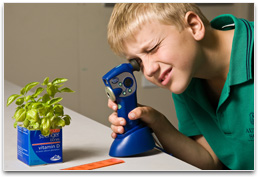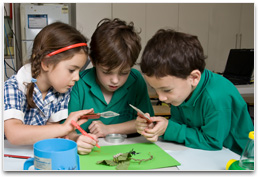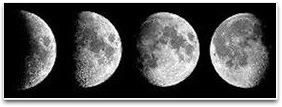This focus idea is explored through:
Contrasting student and scientific views
Student everyday experiences
 Many students think that to do science you need to be in a science laboratory doing experiments and using specialised equipment.
Many students think that to do science you need to be in a science laboratory doing experiments and using specialised equipment.
Research:
Gott, Duggan & Roberts (2003)
When students are doing experiments there may be many unintended outcomes. These may arise from:
- students bringing ideas to the lesson that may be unanticipated
- the scientific problem to be investigated being interpreted in different ways
- the ways in which students undertake the activity varying between different students (sometimes to the point where what students do is not the activity intended).
As a consequence, students’ conclusions may vary even though the data they have may be similar.
Students very often see little connection between experiments and fieldwork – generally ‘fieldwork’ is not perceived to be ‘doing real science’ in their view. The experience of most students is of doing experiments in the formal setting of school classrooms where they have limited opportunities to develop connections with their life experiences. Students often do not acknowledge that doing fieldwork is an equally legitimate way to investigate scientifically.
A related issue is that students frequently have difficulty distinguishing between observations and inferences. For example, consider a piece of chocolate. ‘The chocolate tastes sweet’ and ‘the chocolate is brown’ are observations. An inference goes beyond the observations, usually blending observations with existing knowledge and experience with, in this case, chocolate. For example, many students would ‘look at’ chocolate and say that ‘it is sweet’; since they have not yet tasted it, this is an inference based on their previous experiences and existing knowledge (and one that they will almost always describe as an observation).
Research:
Osborne & Freyburg (1985),
Haslam & Gunstone (1996)
Scientific view
An important part of doing science is observing natural situations and carefully and systematically recording those observations (data). Scientists then look for patterns in this systematically recorded data and create explanations for the patterns. Sometimes these patterns come from drawing inferences about the data. Looking for these patterns increases the chances of being able to predict what might happen next time. Sometimes this is easier to do in a laboratory and sometimes it is easier to do in the field (in the natural context).
Observations are descriptive statements about natural phenomena that are directly accessible to the senses (or an extension of the senses) and about which several observers can reach consensus with relative ease. For example, ‘chocolate is brown’ or ‘chocolate is sweet’.
Inferences are statements about phenomena that are not directly accessible to the senses, for example, ‘chocolate is sweet because of the cocoa it contains’. This would be an inference as the cocoa in the chocolate is not directly accessible to the senses.
Explanations are constructed from the examination of evidence collected during repeated observations. An analysis of the data may reveal patterns from which logical inferences can be formed and tested. Explanations provide us with descriptions of phenomena that help us to better understand why or how they may occur. Explanations that allow us to predict when phenomena will occur are more powerful and valuable than explanations that are solely descriptive.
Systematic observations can be communicated to others so that they, in turn, can make their own observations about the same phenomena. In this way the first set of observations can be either verified or not, and, with repeated attempts to verify these observations, patterns emerge that can help people to predict what might happen in the future.
Critical teaching ideas
- Science is an attempt to explain our natural environment and make predictions about it.
- Observing the natural environment and recording data carefully and systematically is an important process of science.
- Scientists use observations to draw inferences.
- Scientists make systematic observations in order to identify patterns, draw inferences and create explanations.
 Explore the relationships between ideas about observation and fieldwork in the
Concept Development Maps – Scientific Investigations and Scientific World View.
Explore the relationships between ideas about observation and fieldwork in the
Concept Development Maps – Scientific Investigations and Scientific World View.
 Students should be supported to appreciate that when collecting evidence it is important that accurate observations are made and that some thought is given to how these observations are recorded and communicated to others. The notion of observation is an important one and needs be distinguished from an inference.
Students should be supported to appreciate that when collecting evidence it is important that accurate observations are made and that some thought is given to how these observations are recorded and communicated to others. The notion of observation is an important one and needs be distinguished from an inference.
 Many of the focus ideas in the Science Continuum F-10 can be viewed through this lens of observations and inferences.
Many of the focus ideas in the Science Continuum F-10 can be viewed through this lens of observations and inferences.
The following table is useful for helping students gain some understanding of what scientists think about and what they do.
| What scientists think | What scientists do |
|---|
- How to do things
- Where to find out about things
- How to argue they are right
- How to record, what to record
- What information is needed, how and where to find out, who to talk to, what to read
- What the information says
- Whether they believe the information
- What they need to know
- What is the problem, how to solve it
- What patterns in the results can be seen
- What conclusions they can draw
- What to measure, what to use
| - Use equipment
- Measure things
- Make things fair
- Try things out
- Investigate
- Record things
- Draw graphs, pictures and diagrams
- Use a computer
- Look at results
- Write reports
- Ask questions
- Make things
- Test things
|
Research:
Lederman (2006),
Skamp (2004)
Teaching activities
Each of these activities uses some specific science ideas. Using these activities in the context of this focus idea involves two broad learning agendas for students – the content itself and the science process(es) the example illustrates.
Bring out students’ existing ideas
The purpose of this activity is to help students start to discriminate between observations and inferences they draw about observations.
Firstly, have the students look at (but not touch) a single piece of chocolate that is unwrapped and unidentifiable as a common brand (i.e. it does not have recognisable commercial trademarks or a characteristic shape). Assure the students that you know the object is composed of chocolate. Next, ask the students to respond to the question: ‘What observations can you make about this piece of chocolate?’ Collect and record their responses on a whiteboard or large sheet of paper for all the class to see.
Now, show the students a list of prepared statements describing the piece of chocolate that include some observations and some that are not; for example:
The chocolate:
- is brown
- was made in Australia
- is hard
- smells sweet
- melts easily.
Assist the students to decide which of the statements are observations and which are not (are inferences).
Finally, ask the students to reconsider the original class list of responses recorded on the whiteboard with the aim of deciding which of the statements are inferences and which are observations.
Collecting evidence
Students could observe some natural (fieldwork) situations such as:
-
 a plant growing or seeds germinating
a plant growing or seeds germinating - the movement or the changing face of the moon over many days
- the times of sunset and sunrise over a period of weeks or months
- changes that occur in chrysalids they have collected.
Discuss with students what they think will be good ways to record their observations and how many they should make. When the students have recorded sufficient observations have them identify patterns which may exist in the data. Students can then use the patterns they identify to make predictions about what they might observe next time with a similar event. Students should be encouraged to explain why they made these predictions.
Clarifying and consolidating ideas for communication to others
In fieldwork such as that undertaken in the activities above, observing very carefully is important. For example, there are many valuable teaching opportunities that can originate from fieldwork such as collecting caterpillars from the local environment.
When collecting caterpillars, students can pick leaves from the host plant (i.e. leaves that the caterpillars are known to eat). Students can also collect leaves from different plants, so that they can provide the caterpillars with a mix of leaves when they construct a habitat for them in the classroom. Consider using a digital camera to record the size of several different leaves of each type.
When the students return to the classroom, they can put the mixed leaves in with the caterpillars for 1-2 days and then record the size of the same leaves again. Students can be encouraged to answer the following questions:
- What changes in the size of the leaves do they observe?
- How could they measure this change?
- Have they noticed a change in size of both sorts of leaves?
- What do they predict will happen if they feed the caterpillars exclusively on each type of plant?
Students should then be supported to tell their parents about what they have done, with a focus on their parents being able to repeat the activity at home. Students should appreciate that subjecting your work to the scrutiny of others is an important part of verifying your work.
Open discussion via a shared experience
Considering how and what to measure is another important part of scientific work. When engaging in activities like the one above, it is important that students engage in discussion about what will be measured and when measurements will be made (for example the size and type of leaves and how often to measure them), and then how to best record these measurements.
Practise using and building the perceived usefulness of scientific models/ explanations
How will students know if they have made sufficient observations or recorded enough measurements? The answers to these questions will lie in whether students have enough data to identify patterns in the measurements which helps the students in predicting the likely outcomes of future observations. For example, based on observations of their daily food intake will the class mice have enough to eat and drink over the weekend?
 In conducting science investigations such as those above, there are other examples you could explore in the focus ideas
Properties of natural and processed materials or
In conducting science investigations such as those above, there are other examples you could explore in the focus ideas
Properties of natural and processed materials or
Floating and sinking.